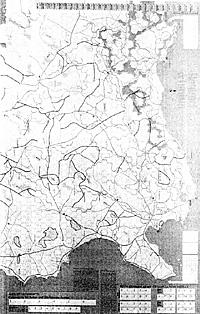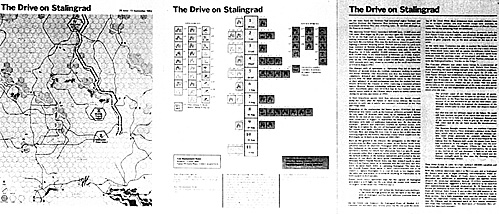At dawn on February 22, 1943, F.M. Erwin Rommel's will broke under a barrage of American artillery fire. Later that day the DAK Kampfgruppe under his command began a retreat back through the hard-won pass at Kasserine, and over the battlefields around Sbeitla, where a detachment took up positions while the rest retired to the Mareth position -- only to be worn down in an uneven attrition battle against Montgomery's Eighth Army.
In late December 1942 F.M. Friedrich Paulus, commanding the beleaguered German 6th Army at Stalingrad, refused to attempt a breakout towards the 4th Panzer Army barely 30 miles away, thus sealing the fate of his own forces and marking a dramatic turning point in the war of Axis aggression.
On February 14, 1943, Lt Gen Lloyd R Fredendall, at his well-concealed and protected command post near Tebessa in Algeria and almost 200 miles from the front line in Tunisia -- was engaged in the important business of losing control of his American II Corps, contributing to a setback in the Allied campaign for Africa.
In each of these situations a decisive military question posed itself to a single man. We are left with the puzzle of their thinking, with all the comfortable hindsight history leaves us to question their decisions. As gamers, we have a unique historical tool with which to study decisive events and the men who shaped them.
OSGs newest games, PANZERKRIEG and ROMMEL & TUNISIA, have as their focus the actions of the commanders in southern Russia and the final act of the dramatic North African campaign, respectively. In each of these games the role of command and leadership was of prime consideration in the design process. The decisions that each of the designers made offer enlightenment into the problems of design.
Elaborate
 ROMMEL & TUNISIA is by design intent a more
elaborate game than PANZERKRIEG. In its attempt
to show tactically flavored campaigns it is much
more demanding of its Players who must be
responsible for distribution of operations resources as
well as the more usual decisions of where to move
what, and when. Both games paint a remarkably
similar picture of the effects of Command and
Leadership and both indeed focus on the men who
made the decisions discussed above.
ROMMEL & TUNISIA is by design intent a more
elaborate game than PANZERKRIEG. In its attempt
to show tactically flavored campaigns it is much
more demanding of its Players who must be
responsible for distribution of operations resources as
well as the more usual decisions of where to move
what, and when. Both games paint a remarkably
similar picture of the effects of Command and
Leadership and both indeed focus on the men who
made the decisions discussed above.
In PANZERKRIEG, with its higher level of abstraction. Players have a depiction of the rise and fall of Army Group South through its combat readiness and capabilities. In ROMMEL & TUNISIA Players have an opportunity to discover the intricacies of tactical planning coupled with logistical allocations in a strategic sense, to gain both tactical and strategic viewpoints in what is essentially an Operational level simulation. In both games Leadership and Command are of prime importance, and both games are equally valid tools and tight contests for Players who understand how to use them.
PANZERKRIEG is an operational level game with one week Game Turns and a distance scale of 14 miles per hex The Game-Turn is divided in a more or iess standard manner with two Player-Turns each consisting of Movement, Combat, Exploitation and Protective Phases Units are generally divisions with Corps sized mechanized units for the Soviets, and a few brigades Units' Strengths range from 1 up to 16. Air units bombard hexes within their range to which they fly during the Movement Phase.
LEADERS are of prime importance; they add their Improvement Strength to units with which they are stacked for both attack and defense. In attacks in which no leaders occupy the defending hex Leaders modify the die roll in favor of the attacker. This die roll modification increases the chances of Breakthrough results -- a special Movement and Combat sequence in which the Phasing Player may participate if eligible. HEADQUARTERS also have distinctive game functions; their presence enables units within their range to attack and are required for effective Combat performance of Axis satellite units.
Possibly more important, and certainly more unique, is the distinctive Reserve dispatch function of HQs within five hexes of a hex which is under attack. At the moment of attack (after final odds calculation) the defending Player may dispatch reserves to the beleaguered hex to bolster its defensive capabilities. HQs which are in an Enemy Zone of Control or which are disrupted or Out of Supply may not dispatch reserves. In PANZERKRIEG, these functions go a long distance towards displaying the decisive effects of Leadership and Command. In practice the alloca tions of effective leadership resources and the proper use of HQs show the Players the importance of these oft neglected aspects of World War II Operations. PANZERKRIEG is a moderately complex simulation with unique and elegant statements to make about the situation facing Erich von Manstein and his predecessors in command of Army Group South.
ROMMEL & TUNISIA is an Operational/Grand Tactical simulation of the Axis and Allied operations which comprised the campaign for Tunisia of November 1942 through May 1943 The Game Turn represents approximately 2 days with weekly allocation of logistical resources. Each hex represents 4.7 miles from side to side. The Game-Turn begins with a Mutual Command Phase, continues through First Player Movement, Second Player Reserve Movement, Combat, Exploitation, then back to Movement with the Players reversing roles.
Upon the completion of three such Game Turns Players undertake the Game Week Interphase in which they receive the logistical resources with which they will pursue their strategy for the upcoming Game- Week. Units range in size from Division down to battalion. Each force in the game is evaluated for troop competence, and each units combat type has a distinct effect on combat in imparting Tactical Advantages. Unit Strengths are relatively narrow in range -- 1 to 3 -- so for truly decisive attacks a Player must develop combined arms teams to achieve decisive odds advantages against his opponent.
The heart of ROMMEL & TUNISIA is the Operations Point. These Operations Points represent the logistical network which backs combat units in the field. The quality of the command chain which is "above" a given attack directly affects the effectiveness of that attack. Air units are flown to target hexes within their range to bombard Enemy units or protect Friendly units. Leaders effect the decisive Command Modifications of the die roll, and are required for distribution of Operations Points, and the relief of unit disruption and depletion.
HQs function in a chain of command which affects the decisive Command die roll modifications, and units trace up a chain of command through HQs to determine the die roll modification to which they are entitled. HQs are also responsible for distribution of the all-important Operations Points. Thus ROMMEL & TUNISIA focuses on the logistical side of Command and Leadership as well as the more direct effects of leadership on the battlefield.

Back to Wargame Design Vol. 1 Nr. 1 Table of Contents
Back to Wargame Design List of Issues
Back to Master Magazine List
© Copyright 1978 by Operational Studies Group.
This article appears in MagWeb (Magazine Web) on the Internet World Wide Web.
Other military history articles and gaming articles are available at http://www.magweb.com